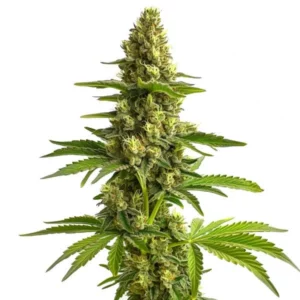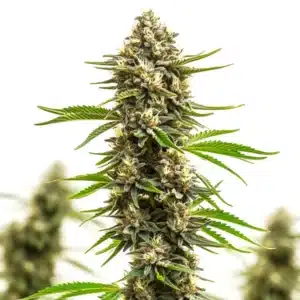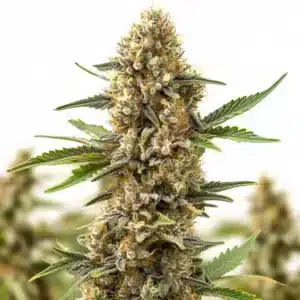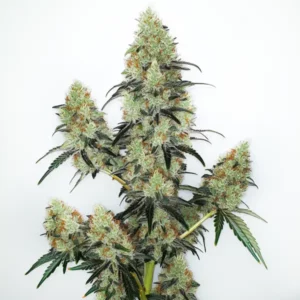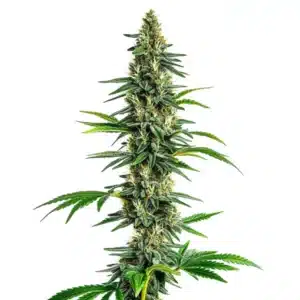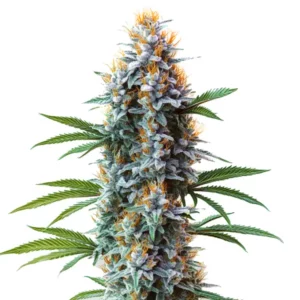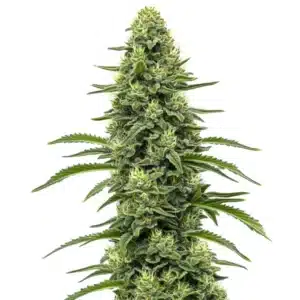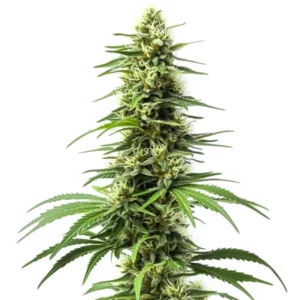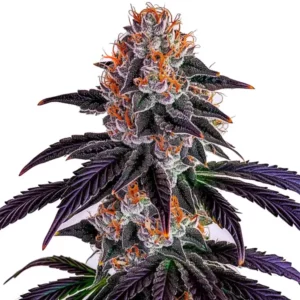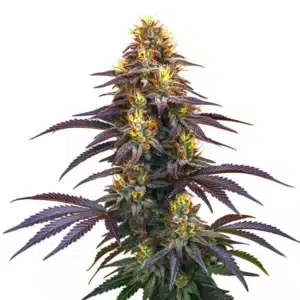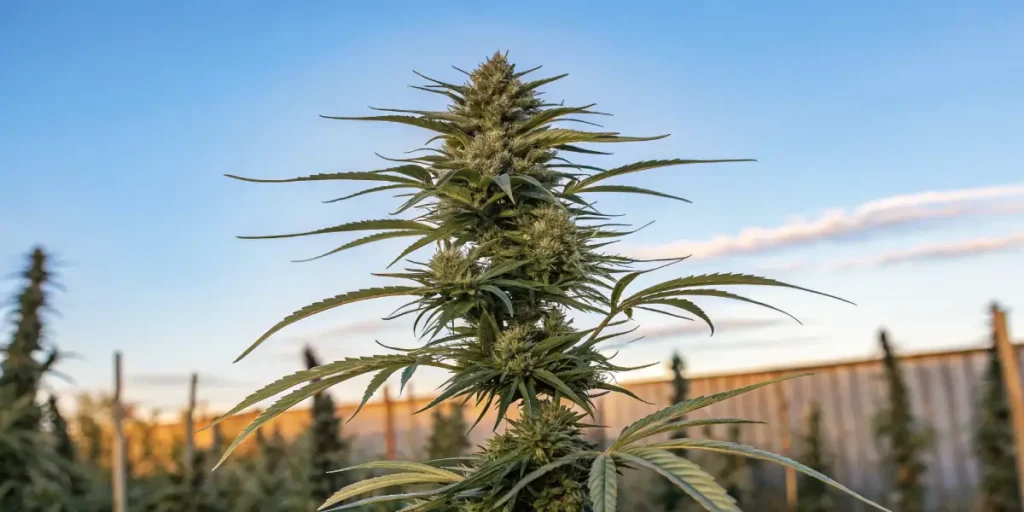
How Cannabis Plants Grow
The journey of how cannabis plants grow is both fascinating and rewarding. Whether you’re a first-time seed buyer or an experienced grower, understanding the growth process can boost your success. Cannabis plants thrive when their needs are met, and this involves knowing the ideal conditions for each stage of growth.
The stages of cannabis plant growth cycle begin with germination. This is when the seed sprouts and baby roots emerge. As it progresses, the plant enters the seedling stage, where it develops its first true leaves. These leaves are vital for photosynthesis, the process by which plants use light to create food. As the plant matures, it goes through the vegetative stage, where it grows rapidly, and then the flowering stage, where buds form.
Recommended Strains
Blue Dream
|
|
THC | 17% - 24% (Medium) |
|
|
Type | Feminized |
|
|
Yield | High |
|
|
Phenotype | 50% Indica / 50% Sativa |
Bruce Banner #3
|
|
THC | 20% - 29% (High) |
|
|
Type | Feminized |
|
|
Yield | Medium |
|
|
Phenotype | 50% Indica / 50% Sativa |
Choosing the right strain from Blimburn Seeds can make a significant difference in how cannabis plants grow. For example, the Blue Dream strain is known for its resilience and generous yield, making it ideal for both beginners and seasoned growers. By selecting the right strain, you can ensure that your plants have the best chance of thriving.
How Cannabis Plants Grow Indoors
Growing cannabis indoors gives you control over the environment, which is crucial for success. Indoor growers can adjust factors like lighting, temperature, and humidity to optimize how cannabis plants grow. This control means you can grow year-round, regardless of outdoor weather conditions.
Lighting requirements for cannabis plant growth are critical when growing indoors. Cannabis plants need about 18 hours of light per day during the vegetative stage and 12 hours during the flowering stage. LED lights are popular due to their efficiency and low heat output. Proper lighting ensures that your plants can photosynthesize efficiently, which is essential for growth.
Another advantage of indoor growing is the ability to control pests and diseases more effectively. By maintaining a clean and controlled environment, you can reduce the risk of infestations that might otherwise hinder how cannabis plants grow indoors. Using organic pest control methods can further enhance plant health without introducing harmful chemicals.
Additionally, how cannabis plants grow indoors can be influenced by the choice of growing medium. Some growers prefer hydroponics or aeroponics, systems that use nutrient-rich water instead of soil. These methods can accelerate growth rates and improve yields, though they require careful monitoring and management to ensure optimal results.
Stages of Cannabis Plant Growth Cycle
The germination stage marks the beginning of the cannabis life cycle. During this time, seeds need a warm, dark environment to sprout. Many growers use the paper towel method, where seeds are placed between moist paper towels until they crack open and roots start to show. This stage typically lasts 1-7 days.
Once the seedling emerges, it enters the seedling stage, which lasts about 2-3 weeks. During this phase, the plant focuses on developing its root system and growing its first leaves. These leaves are small and delicate, and the plant requires careful handling. Maintaining a consistent light schedule and providing adequate water is crucial during this stage.
The transition from the seedling stage to the vegetative stage is marked by a significant increase in growth rate. During the vegetative stage, which can last 3-16 weeks, plants develop strong stems and a robust root system. This stage is crucial for determining the plant’s structure and potential yield, making it an important focus for growers seeking to optimize how cannabis plants grow.
The final stage of the cannabis plant growth cycle is the flowering stage. This is when the plant begins to produce buds, and growers must adjust lighting cycles to stimulate this process. Flowering typically lasts 6-8 weeks, but the duration can vary depending on the strain and growing conditions. Proper care during this stage ensures a successful harvest.
Best Soil for Cannabis Plant Growth
The best soil for cannabis plant growth is one that provides a balance of aeration, drainage, and nutrient retention. Loamy soil, which is a mixture of sand, silt, and clay, is often recommended. It provides excellent drainage while retaining the nutrients and moisture that cannabis plants need.
When selecting soil, consider the pH level, which should be between 6.0 and 7.0 for cannabis plants. You can test the soil pH using a simple soil test kit. Adjusting the pH as needed ensures that your plants can effectively absorb nutrients, which is vital for healthy growth.
Soil composition can significantly influence how cannabis plants grow. Adding perlite or vermiculite to your soil mix can improve aeration and drainage, preventing issues like root rot. These amendments help maintain a light and fluffy soil structure conducive to healthy root development.
Another consideration is the inclusion of organic matter in your soil, such as bat guano or bone meal. These natural fertilizers provide essential nutrients that support vigorous growth throughout the plant’s life cycle. By enriching the soil with these elements, you can create a fertile environment that promotes the best soil for cannabis plant growth.
How to Optimize Cannabis Plant Growth
To optimize cannabis plant growth, it’s essential to provide the right balance of light, nutrients, water, and air. Each element plays a crucial role in the plant’s development and overall health. Properly managing these factors can result in robust growth and high yields.
Nutrients are vital for how cannabis plants grow. Cannabis requires three primary nutrients: nitrogen (N), phosphorus (P), and potassium (K). During the vegetative stage, plants need higher nitrogen levels, while the flowering stage requires more phosphorus and potassium. Many growers use nutrient schedules to ensure their plants receive the right proportions at each growth stage.
Besides to basic nutrients, trace elements such as calcium, magnesium, and iron are essential for optimal cannabis plant growth. These micronutrients support various physiological processes and help prevent deficiencies that can impair plant health. Regularly testing and adjusting nutrient levels can ensure your plants receive a balanced diet.
Pruning and training techniques are also effective ways to optimize how cannabis plants grow. Methods like topping or FIM’ing can encourage bushier growth and increase bud sites. These practices, combined with proper environmental control, can enhance light penetration and improve overall plant structure, leading to higher yields.
Promos & Deals
Lighting Requirements for Cannabis Plant Growth
Lighting is one of the most critical requirements for cannabis plant growth. Without adequate light, plants cannot photosynthesize, which is necessary for producing the energy they need to grow and thrive. Different stages of growth require different light cycles and intensities.
During the vegetative stage, cannabis plants thrive under a longer light cycle of 18-24 hours of light per day. This mimics the long days of summer and encourages vigorous growth. Many growers use metal halide (MH) or LED lights during this stage as they provide the blue spectrum light that supports leafy growth.
In contrast, the flowering stage requires a shorter light cycle of 12 hours of light and 12 hours of darkness to stimulate bud development. High-pressure sodium (HPS) lights or full-spectrum LEDs are often used during this stage as they emit the red spectrum light that encourages flowering. Adjusting the light cycle at the right time is crucial for triggering the flowering process.
Investing in quality lighting systems is key to meeting the lighting requirements for cannabis plant growth. Dimmable LEDs and programmable timers allow for precise control over light intensity and cycles, enabling growers to fine-tune conditions to suit their plants’ needs. This level of control can significantly impact how cannabis plants grow by ensuring they receive optimal light exposure throughout their life cycle.
Reflective materials like Mylar or white paint can also enhance lighting efficiency by reflecting light back onto the plants. This not only maximizes light utilization but also helps to prevent light wastage, contributing to more efficient energy use and better overall plant health.
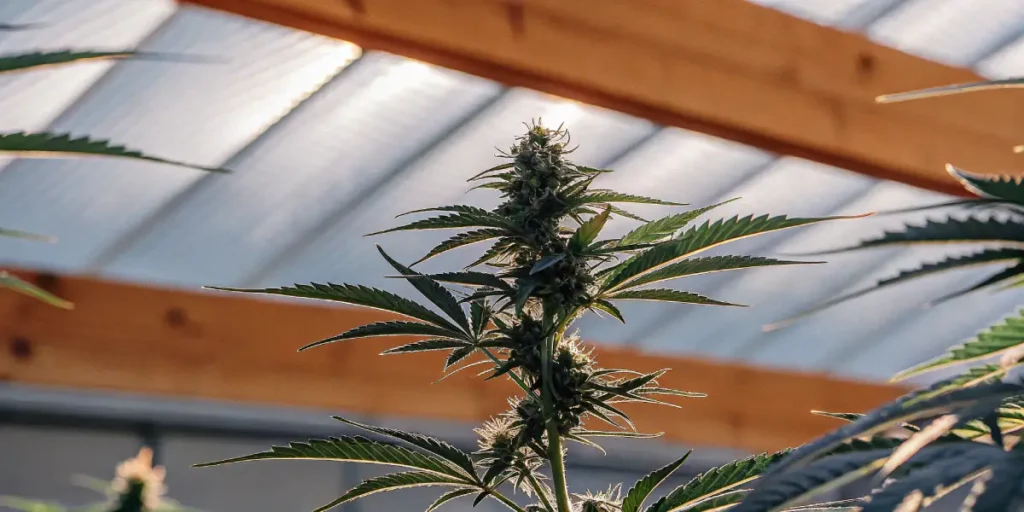
FAQs
What are the ideal conditions for cannabis plant growth?
Cannabis plants grow best in controlled environments where temperature, humidity, and light conditions are optimized. During the vegetative stage, maintain temperatures between 70-85°F and humidity around 40-60%. In the flowering stage, reduce the humidity to 40-50% to prevent mold and bud rot.
Lighting is crucial, with 18 hours of light in the vegetative stage and 12 hours in the flowering stage. Ensure you use the right type of light for each stage, such as MH or LED during vegetative growth and HPS or full-spectrum LEDs during flowering. Additionally, good air circulation and proper nutrient management are essential for healthy growth.
Proper ventilation is essential to maintain the ideal conditions for cannabis plant growth. Fresh air exchange helps control temperature and humidity while supplying plants with the carbon dioxide they need for photosynthesis. Incorporating fans and exhaust systems can effectively manage air flow within your grow space.
Regular monitoring and adjustment of growing conditions can also prevent common issues such as nutrient burn or light stress. Keeping a detailed grow diary allows you to track environmental changes and plant responses, helping you fine-tune your setup for optimal results.
How can I improve my indoor cannabis plant yield?
Improving indoor cannabis plant yield involves optimizing several factors. First, ensure your plants receive adequate light, as it directly affects photosynthesis and growth. Use reflective materials to maximize light exposure and prevent shadows.
Secondly, consider training techniques like topping or low-stress training to increase bud sites and improve light penetration. Providing the right nutrients at each growth stage is also critical. Monitor your plants closely and adjust your care routine based on their specific needs and responses.
Maintaining proper environmental conditions is also crucial for maximizing yield. Consistent temperature and humidity levels, along with regular feeding schedules, contribute to how cannabis plants grow and produce. Implementing an automated system can help maintain these parameters more consistently and reduce the risk of human error.
Genetic selection plays a significant role in yield potential. Choosing high-yielding strains and those bred for resilience can provide a better foundation for achieving large harvests. Exploring different genetics can lead to finding a strain that thrives in your specific growing environment.
What are common mistakes when growing cannabis indoors?
One common mistake is improper watering. Overwatering can suffocate roots and lead to disease, while underwatering can stress the plant. It’s essential to find a balance and ensure your pots have good drainage.
Another mistake is not monitoring the pH level of your growing medium. Cannabis plants require a slightly acidic environment (pH 6.0-7.0) to absorb nutrients effectively. Regularly test and adjust pH levels to avoid nutrient lockout, which can stunt growth and reduce yields.
Neglecting pest control is another frequent oversight. Even in indoor environments, pests like spider mites or fungus gnats can become problematic. Implementing preventative measures and inspecting plants regularly can help catch issues early before they escalate.
Failing to provide adequate light is also a common error. Insufficient lighting can lead to weak, leggy plants with lower yields. Ensuring that your lighting setup meets the specific requirements for each growth stage is vital for supporting vigorous plant development.
Which cannabis strains are best for beginners?
For beginners, selecting a strain known for its resilience and ease of growth is beneficial. A strain like Bruce Banner 3 from Blimburn Seeds is an excellent choice. It is forgiving of minor mistakes and produces a generous yield.
Additionally, autoflowering strains can be advantageous for beginners, as they don’t require specific light cycles to flower. These strains automatically transition to the flowering stage, making them easier to manage for those new to cannabis cultivation.
Another beginner-friendly option is Northern Lights, a classic strain renowned for its hardiness and resistance to common pests and diseases. Its ability to thrive under various conditions makes it a reliable choice for those learning how cannabis plants grow.
Blue Cheese is another strain that offers ease of growth coupled with a unique flavor profile. Its relatively short flowering time and compact size make it ideal for indoor growers with limited space, while still delivering satisfying yields.
How does soil choice affect cannabis plant growth?
The choice of soil significantly impacts how cannabis plants grow. Soil provides essential nutrients, supports root structure, and affects water retention and drainage. A well-aerated and nutrient-rich soil promotes healthy root development and strong plant growth.
Using a high-quality soil mix or amending your soil with organic matter can improve its fertility and structure. Avoid heavy clay soils that retain too much water, as they can lead to root rot. Instead, choose loamy soil or customize your mix to create an optimal growing environment for your cannabis plants.
Different soil types can also influence the flavor and aroma of the finished product. Organic soils enriched with natural amendments can enhance the terpene profile, resulting in more aromatic and flavorful buds. This is another reason why selecting the best soil for cannabis plant growth is crucial for achieving high-quality results.
Additionally, soil choice can affect the sustainability of your growing practices. Opting for organic, sustainable soil amendments supports environmentally friendly cultivation methods, contributing to a healthier ecosystem and potentially improving the overall health of your cannabis plants.



